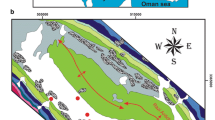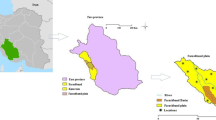Abstract
Groundwater over-exploitation leading to quality deterioration is an accepted fact, but limited work in this direction has been carried out in the Indian state of Punjab, where groundwater development is 172 %, the highest of any state in India. This paper makes an assessment of the groundwater quality in three administrative blocks of Rupnagar district in Punjab, in two of which groundwater exploitation has already reached about 200 %. Sixty groundwater samples were collected from shallow tubewells and hand pumps in premonsoon season (May, 2013) and were analyzed for major chemical parameters. Analytical results do not show any perceptible deterioration in groundwater quality; all the parameters are well within the permissible limits of the Indian standards, except for electrical conductivity (EC), total dissolved solids (TDS), Ca and Mg, which exceed the desirable limits in few groundwater samples. Abundance of ions in the water samples is in the order: HCO3 − > Cl− > SO4 2− > NO3 − and Mg2+ > Ca2+ >N a+ > K+. Data plotted on the US Salinity Laboratory diagram show that most of the samples fall in the category of C2S1 and C3S1, which makes the groundwater suitable for irrigation in all types of soil. Other chemical indices such as % sodium (%Na), sodium absorption ratio (SAR), and residual sodium carbonate (RSC) also show that almost all samples are fit for irrigation purposes. This work thus concludes that groundwater quality deterioration due to irrigation has not yet been well perceived in the state of Punjab, even if much of its groundwater resources have been over-exploited. However, the paper warns against indiscriminate drilling and over-exploitation of the groundwater resources for their long-term usage and sustainability.












Similar content being viewed by others
References
APHA (2005) Standard methods for the examination of water and wastewater, 21st edn. American Public and Health Association, New York
Bureau of Indian Standards (BIS) (2012) Specifications for drinking water, IS: 10500:2012. Bureau of Indian Standards, New Delhi
CGWB (Central Groundwater Board) (2013) Report on dynamic groundwater resources of Punjab state (as on March 2011). Central Groundwater Board, North Western Region, Chandigarh, pp 1–135
CGWB (Central Groundwater Board) (2014) Report on dynamic groundwater resources of India (as on March 2011). Central Groundwater Board, Ministry of Water Resources, River Development and Ganga Rejuvenation, Government of India, Faridabad, pp 1–282
Chadha DK (1999) A proposed new diagram for geochemical classification of natural waters and interpretation of chemical data. Hydrogeol J 7:431–439
Chaudhary RS (1971) Nahan—a problematic horizon of N. W. Himalayas. J Geol Soc India 12(4):373–377
Custodio E (2002) Aquifer overexploitation, what does it mean? Hydrogeol J 10:254–277
Davies SN, De Wiest RJ (1966) Hydrogeology. Wiley, New York, pp 1–463
Dhar A, Sahoo S, Mandal U, Dey S, Bishi N, Kar A (2015) Hydro-environmental assessment of a regional groundwater aquifer: Hirakud command area (India). Environ Earth Sci 73(8):4165–4178
Domenico PA, Schwartz FW (1990) Physical and chemical hydrogeology. Wiley, New York, pp 410–420
Doneen LD (1964) Notes on water quality in agriculture. Published as a water science and engineering paper, 4001, Department of water science and engineering, University of California
Eaton FM (1950) Significance of carbonates in irrigation waters. Soil Sci 39:123–133
Fetter CW (1994) Applied hydrology, 3rd edn. Prentice Hall, Inc., New Jersey, pp 420–425
Foster SSD (1995) Groundwater for development: an overview of quality constraints. In: Nash H, McCall GJH (eds) Groundwater quality 17th special report. Chapman and Hall, London, pp 1–3
Gardner-Outlaw T, Engelman R (1997) Sustaining water, easing scarcity: a second update, revised data for the population action international report. Sustaining Water: Population and the Future of Renewable Water Supplies. Population and Environment Program, Washington, p 18
Gibbs RJ (1970) Mechanism controlling world water chemistry. Science 170:1088–1090
GoP (Government of Punjab) (2013) Agricultural policy for Punjab. Department of Agriculture, Govt. of Punjab, Punjab, pp 1–58
GoP (Government of Punjab) (2014) Economic survey of Punjab. Government of Punjab, Punjab
Gupta SK, Deshpande RD (2004) Water for India in 2050: first-order assessment of available options. Curr Sci 86(9):1216–1223
GWREC (Groundwater Resources Estimation Committee) (1997) Report of groundwater resource estimation committee. Ministry of Water Resources, Government of India, New Delhi
Handa BK (1969) Description and classification of media for hydro-geochemical investigations. In: symposium on groundwater studies in Arid and Semiarid regions, Roorkee, India
Hem JD (1991) Study and interpretation of the chemical characteristics of natural waters. Book 2254, 3rd edn. Scientific Publishers, Jodhpur, p 263
Howari FM, Abu-Rukah Y, Shinaq R (2005) Hydrochemical analysis and evaluation of groundwater resources of north Jordan. Water Resour 32(5):555–564
Ishaku JM (2011) Assessment of groundwater quality index for Jimeta-Yola area, Northeastern Nigeria. J Geol Min Res 3(9):219–231
Jain CK, Bandyopadhyay A, Bhadra A (2010) Assessment of groundwater quality for drinking purpose, district Nainital, Uttarakhand, India. Environ Monit Assess 166:663–676
Katpatal YB, Pophare AM, Lamsoge BR (2014) A groundwater flow model for overexploited basaltic aquifer and Bazada formation in India. Environ Earth Sci. doi:10.1007/s12665-014-3342-2
Lapworth DJ, Gopal K, Rao MS, MacDonald AM (2014) Intensive groundwater exploitation in the Punjab: an evaluation of resource and quality trends. British geological survey open report OR/14/068 Nottingham, UK, p 34
Ophori DU, Toth J (1989) Patterns of groundwater chemistry, Ross Creek Basin, Canada. Groundwater 27:20–26
Pascoe E (1959) A manual of the geology of India and Burma, vol 7. Govt. of India, Press, Calcutta, pp 1980–2016
Piper AM (1944) A Geographic procedure in the geochemical interpretation of water analysis. Trans Am Geophys Union 25:914–928
Plummer LN, Bexfield LM, Anderholm SK (2003) How ground-water chemistry helps us understand the aquifer. In: Bartolino JR, Cole JC (eds) U.S. Geological Survey Circular 1222, pp 92–93
Pophare AM, Lamsoge BR, Katpatal YB, Nawale VP (2014) Impact of over exploitation on groundwater quality: a case study from WR-2 watershed, India. J Earth System Sci 123(7):154–1566
Purushothaman P, Rao MS, Rawat YS, Kumar CP, Krishan G, Parveen T (2014) Evaluation of hydrogeochemistry and water quality in Bist-Doab region, Punjab, India. Environ Earth Sci 72(3):693–706
Richards LA (ed) (1954) Diagnosis and improvement of saline alkali soils.US Department of Agriculture Hand Book 60, p 160
Sastri JCV (1994) Groundwater chemical quality in river basins, hydrogeochemical modeling. Lecture notes: refresher course, School of Earth Sciences, Bharathidasan University, Tiruchirapalli
Sawyer GN, McCartly DL (1967) Chemistry of sanitary engineers, 2nd edn. McGraw-Hill, New York, p 518
Schoeller H (1977) Geochemistry of groundwater, Chap. 15. In: Brown RH, Konoplyantsev AA, Ineson J, Kovalevsky VS (eds) Groundwater studies: an international guide for research and practice. UNESCO, Paris, pp 1–18
Singh H (1983) Crop production in India. Agric Situat India 38:635–639
Singh AK (2003) Water resources and their availability. In: Souvenir, national symposium on emerging trends in agricultural physics, Indian Society of Agrophysics, New Delhi, 22–24 April 2003, 18–29
Subba Rao N (2002) Geochemistry of groundwater in parts of Guntur district, Andhra Pradesh, India. Environ Geol 41:552–562
Subba Rao N (2007) Groundwater quality as a factor for identification of recharge zones. Environ Geosci 14:79–90
Subramani T, Elango L, Damodarasamy SR (2005) Groundwater quality and its suitability for drinking and agricultural use in Chithar River Basin, Tamil Nadu, India. Environ Geol 47:1099–1110. doi:10.1007/s00254-005-1243-0
Todd DK (1980) Groundwater hydrology. Wiley, New York 535p
Tularam GA, Krishna M (2009) Long term consequences of groundwater pum** in Australia: a review of impacts around the globe. J Appl Sci Environ Sanit 4(2):151–166
United Nations (UN) (2004) 58th session, A/Res/58/217. http://www.un.org/waterforlifedecade/reference. html
United States Salinity Laboratory (USSL) (1954) Diagnosis and improvement of saline and alkali soils, handbook 60. US Department of Agriculture, New York
Wadia DN (1979) Geology of India. Tata McGraw Hill Publishing Co., Ltd., New Delhi, p 508
Wilcox LV (1955) Classification and use of irrigation waters. US Department of Agriculture, New York (circulation, 969, 19)
Acknowledgments
University Grants Commission (UGC), New Delhi, India provided financial support to the first author to pursue this research apart from many others. Constructive comments received from the three anonymous reviewers are gratefully acknowledged. Groundwater level data were collected from the Central Ground Water Board, North Western Region, Chandigarh, India.
Author information
Authors and Affiliations
Corresponding author
Rights and permissions
About this article
Cite this article
Thakur, T., Rishi, M.S., Naik, P.K. et al. Elucidating hydrochemical properties of groundwater for drinking and agriculture in parts of Punjab, India. Environ Earth Sci 75, 467 (2016). https://doi.org/10.1007/s12665-016-5306-1
Received:
Accepted:
Published:
DOI: https://doi.org/10.1007/s12665-016-5306-1




